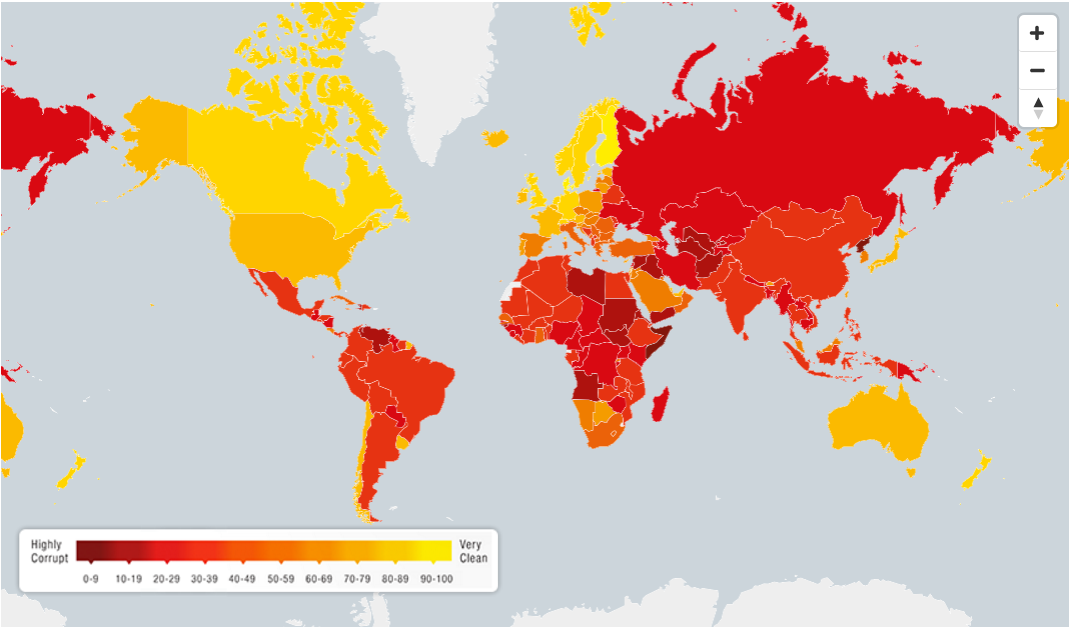
It is, however, important to recognize that, like any insidious disease, corruption presents multiple myths or red herrings to obfuscate its source and elude attempts to cure it. The following aims to wade through each of these red herrings, and identify where in the societal body we might administer a treatment to attack corruption at its true source.
by
Bo Rothstein*
The use of this terminology indicates that this is a social ill that starts at some place in the body and then spreads as it infects ever more cells. If this metaphor has any value, it is important to find the right location of the corruption problem in the “societal body”. If you do not know where the illness is located, the likelihood that you can cure it is of course minimal.
It is, however, important to recognize that, like any insidious disease, corruption presents multiple myths or red herrings to obfuscate its source and elude attempts to cure it. The following aims to wade through each of these red herrings, and identify where in the societal body we might administer a treatment to attack corruption at its true source.
Myth 1: Structuralism
We begin our search where many researchers have, by examining societal structures that may harbour the source of corruption. The increase in large data sets has allowed advanced statistical analysis of what differentiates countries with high and low levels of corruption.
Countries dominated by Lutheranism, that are geographically relatively small, that have not had a history of exploitation by colonial powers, and that are relatively ethnically homogenous have fared better. These research results are certainly valuable, but they are also beyond the scope and sphere of influence of current public policies. Just as a cancer patient asking her doctor for a possible cure is not helped by the advice that she should have chosen other parents, researchers often confuse the notion of statistical significance with policy significance.
Myth 2: Behaviouralism
Another spectrum of explanations in search of this disease focuses on behavioural issues like the level of integrity and the standard of ethics of politicians, civil servants and other professional groups in the public sector. It goes without saying that a country with high moral standards in the civil service would not suffer from systemic corruption. The problem with this type of analysis is that the explanatory variables are hard to distinguish from what is to be explained. It is close to a tautology to say that what explains low levels of corruption in a country is a high ethical standard among politicians, judges, and civil servants. In reality, this line of reasoning does not have any explanatory power; instead it is more a repetition of the data.
Myth 3: Institutionalism
The alternative to structural and behavioural explanations is to focus on the importance of institutions. Importantly, institutions are constructed and reproduced (and sometimes destroyed) by humans and thus, in principle, open for policy-induced change. The “enemy”, so to speak, is at least – in principle – possible to defeat. Institutions can be formal and informal, and so we need to know which are the most important to address to lower the level of corruption. This is an issue where the research now seems to provide a clear answer, namely that the importance of formal institutions has been much overrated.
A case in point is Uganda, which after numerous interventions by donors, has established an institutional framework that, according to the Swedish International Development Cooperation Agency, was “largely satisfactory in terms of anti-corruption measures”. Uganda’s formal institutions of anti-corruption regulation score 99 out of 100 points in the think tank Global Integrity’s index, yet the country is, according to existing measures, one of the most corrupt in the world.

Another case in point is Italy. Studies of corruption in this country show remarkably large variation between its southern and northern regions. Yet, this is a country that has had the same formal institutions for 150 years! This result implies that the strong focus on changing national formal institutions, such as the introduction of special national anti-corruption agencies, and more stringent laws, in all likelihood, is a misplaced anti-corruption strategy. This is not to say that national laws against corruption are unimportant, but it is obvious from the Italian example that they are far from sufficient. As of today, many, if not most, highly corrupt countries have stringent formal laws against corruption.
Myth 4: Culturalism
Does this lack of importance of formal institutions imply that corruption is somehow ingrained in the traditional culture of places like Sicily and other highly corrupt societies? This is the widespread understanding in anthropology, but, to an increasing degree, also in economics. Many anthropologists, being prone to cultural relativism, use culture to excuse corruption, largely disregarding the vast amount of empirical research showing its detrimental effects on almost all aspects of human well-being. Economists, however, blame the cultures in highly corrupt societies, labelling them “dysfunctional”.
“Culture” is often conflated to mean the general moral orientation of the population in question, but there are (at least) two problems with this understanding of corruption. The first is a lack of empirical support: respondents in the Afro-Barometer survey for 18 sub-Saharan African countries were asked their views on the following scenarios where an official: “decides to locate a development project in an area where his friends and supporters live”; “gives a job to someone from his family who does not have adequate qualifications”; and “demands a favour or an additional payment for some service that is part of his job”. Between 60% to 76% of the 25,086 respondents consider all three examples of corruption as “wrong and punishable”, while only a small minority view such actions as “not wrong at all”.
Similar results have been reported from India. A clear majority of villagers in deeply corrupt regions in India responded that they deemed it “very important” that civil servants “treat everyone equally, regardless of income, status, class, caste, gender and religion”, and also that civil servants “should never under any circumstances accept bribes”.
The second problem with the “culturalist” approach to corruption is how to relate it to policy. Morally blaming the culture of a nation is not very different from saying that “you are dishonest and bad people”. This is likely not a good start for achieving broad policy change.
The problem is that these analyses conflate culture as a moral orientation with informal institutions. It should be obvious that informal institutions and moral values are two different things. Philosophers have argued for a distinction between “moral norms” and “social norms” as being “fundamentally different”. Moral norms “justify the relevant normative principle”, while social norms consist of the “presumed social practice”. For example, if travelling in a country where you learn that the “presumed social practice” for getting medical treatment for one’s children is to pay the health personnel bribes, most people would pay.
However, the parent could still be morally upset and convinced that doing so is ethically wrong. Similarly, a doctor in a systemically corrupt health care system may morally disapprove of the practice of taking money “hidden in an envelope”, but it makes little sense to be the only honest player in a system where this is the “presumed social practice”. Dysfunctional informal institutions are not necessarily to be understood as part of a culture if by culture we understand moral “beliefs” and “values”.
The Source: “Rules in Use”
The question is, then, if there some social entity between formal institutions and culture as a moral orientation that can solve the problem of where corruption is located in the “societal body”?
An answer to this was put forward by Nobel Laureate Elinor Ostrom when she suggested that we should distinguish between “rules in form” and “rules in use”. Organizational theorists have suggested that between culture and formal institutions exists a type of informal institution labelled “standard operating procedures”. These are rules that are not formalized, are well-known to the participants, but, importantly, are not necessarily part of their moral orientation. They are thus similar to what philosophers label as “social norms”.
In a thoroughly corrupt setting, even people who think corruption is morally wrong are likely to take part because they see no point in doing otherwise. There is a clear distinction between understanding corruption as ingrained in the moral fabric of a society, versus corruption as “standard operating procedures” that may force people to act in ways they think are morally wrong.
From a policy perspective, this may be good news. While there is very little knowledge of how to change the culture (understood as the moral norms) of a society, there is a considerable amount of research on how “standard operating procedures” can be changed through collective action. We have tangible examples in the near-elimination of practices like foot-binding and genital mutilation of young girls, and how organizations have built trust back into systems in which people had previously become disillusioned.
Through focused policy initiatives aimed at such “rules in use” and “standard operating procedures”, we might finally be able to challenge corruption at its source, and provide a long-term cure to a disease that has afflicted our societal body for far too long.
*Professor of Government and Public Policy, University of Gothenburg




